Calendarizing © SM is a verb I created.
A “grain of salt” will be needed
Calendarizing is about working something out in time
and having the next step on your calendar.
The actual results of action are not predictable
For example, what thinking and actionS would be necessary to calendarize
how to guarantee non-performance?
“To know something,
to really understand something important,
one must look at it from sixteen different angles.
People are perceptually slow,
and there is no shortcut to understanding;
it takes a great deal of time.” PFD read more
Everything that follows is essentially
an attention directing placeholder

An action system
Radar system ::: Calendarization ::: Conceptual resource digestion ::: Concepts to daily action
The secret office
History of The World In Two Hours
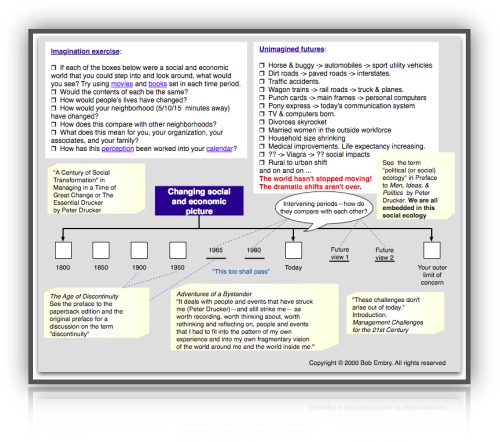
The Sweep of History and Thinking about Time Usage
Managing in the Next Society

Calendarizing involves creating a comprehensive
semi-dated action plan.
There are limits to precision
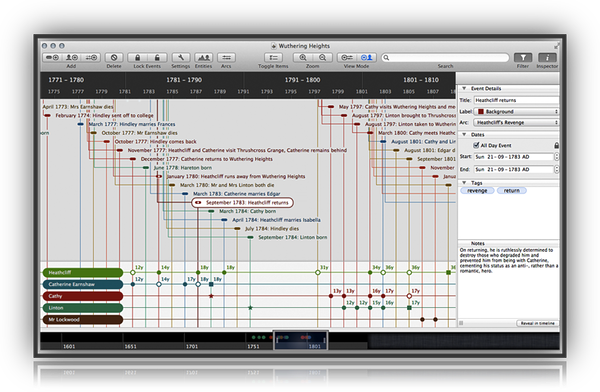
Larger ::: Aeon Timeline
Calendarizing applies to an important, major broad topic and expresses your desire to direct your attention to that topic on a systematic, foolproof basis.
Topic thinking
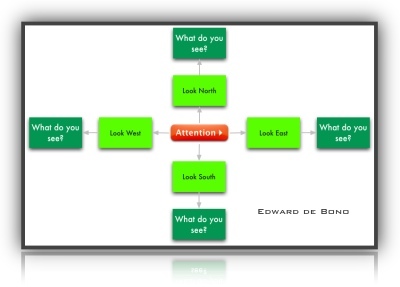
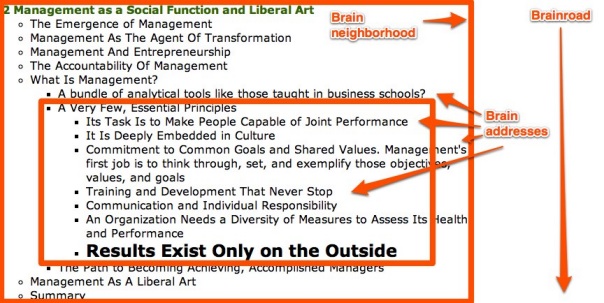
Because we live in an unfolding world it may not be entirely clear what the real broad topic is — finding out may be part of the calendarization.
If you ran across the following in a book or elsewhere, would you calendarize it? How?
… the center of a modern society, economy and community is not technology. It is not information. It is not productivity. The center of modern society is the managed institution. The managed institution is society’s way of getting things done these days. And management is the specific tool, the specific function, the specific instrument, to make institutions capable of producing results. The institution, in short, does not simply exist within and react to society. It exists to produce results on and in society. — Peter Drucker, Management’s New Paradigm
The 90/10 Rule at Yum! Brands
But every analysis of actual allocation of resources and efforts in business that I have ever seen or made showed clearly that the bulk of time, work, attention, and money first goes to ‘problems’ rather than to opportunities, and, secondly, to areas where even extraordinarily successful performance will have minimal impact on results. (calendarize this?)
One of the hardest things for a manager to remember is that of the 1,000 different situations he or she will be asked to deal with on any given day, only the smallest handful have a shot at moving the enterprise forward in a truly significant way (calendarize this?)
The job of management, then, is to make sure that financial capital, technology, and top talent are deployed where most of the results are and where most of the costs aren’t. The temptation often exists, however, to do exactly the opposite
See chapter 10, The Bright Idea (the riskiest and least successful source of innovative opportunities) in Innovation and Entrepreneurship
Post-capitalist society ::: the transformation
Before jumping off into the deep end, it would be a really, really good idea to have read through Peter Drucker’s life and career guidance topics. What you harvest from these should help shape your calendarization needs.
You first add the topic to your master radar list and then make a calendar appointment with yourself to begin work on that topic.
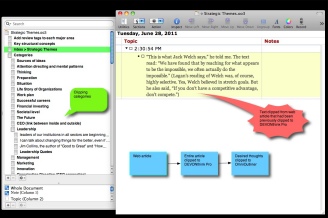
Larger view
That first appointment may involve including the topic in one of your review sessions.
For more on reviews see the third and fourth experiences in Peter Drucker’s “My Life as a Knowledge Worker,” Living in More Than One World: How Peter Drucker’s Wisdom Can Inspire Your Life by Bruce Rosenstein and David Allen’s weekly reviews.
Calendarizing involves the action of identifying implementation steps to be taken in time—including a foolproof next action reminder on your calendar.
Calendarizing is the action of “choreographing” the action related to a broad topic in a changing world—a world moving toward unimagined futures.
Calendarizing involves THINKING
Inside Man, The Thomas Crown Affair — 1968, The Next Three Days and The Prince offer thinking choreography examples
Think about uncertainties, constraints, barriers, counter-attacks and responses …
How about some Drucker thinking
If something can be done it can be calendarized. If something can’t be done yet, what can be calendarized to make it doable? See The Management Revolution
Calendarization begins with first exposure (see below) and ends following abandonment attempts—things take on a life of their own which doesn’t necessarily end when we want. There needs to be a future calendar entry until no further action can be taken.
The first step: What thinking is needed? Where does this topic fit in the world and in my worldS? Today and Tomorrow
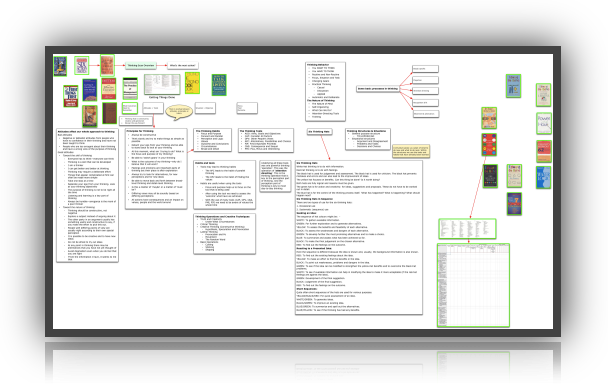
Larger view (wip)
Every further “step” along the way is an opportunity for attention directing and making connections. Things will change. Mistakes will have been made and will need to be corrected.
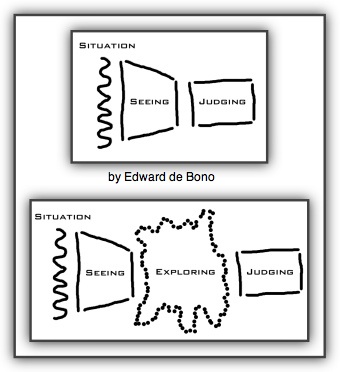
First exposure can be the result of a systematic search, horizon scanning or some other process. This time-life navigation © (TLN) site is an example of a systematic search.
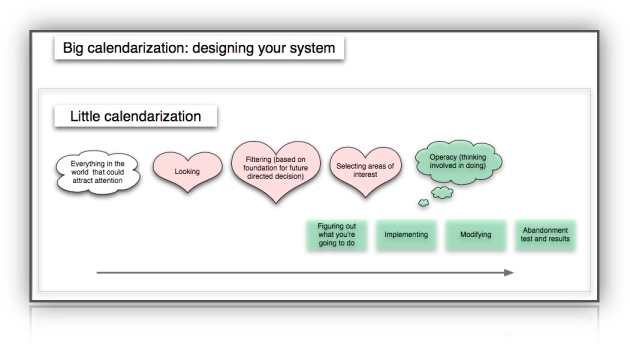
Larger view
Or first exposure may occur while reading or seeing something. Below are a couple of examples that seem pretty general but definitely need to be on someone’s radar.
Increasingly, the policy of any country—and especially of any developed country—will have to give primacy to the country’s competitive position in an increasingly competitive world economy.
Any proposed domestic policy needs to be shaped so as to improve the country’s competitive position in the world economy or, at the least, so as to minimize adverse impacts on it.
The same holds true for policies and strategies of any institution within a nation, whether a local government, a business, a university, or a hospital.
One consequence of this is that every business must become globally competitive, even if it manufactures or sells only within a local or regional market.
The competition is not local anymore—in fact, it knows no boundaries.
Every company has to become transnational in the way it is run.
Yet the traditional multinational may well become obsolete.
It manufactures and distributes in a number of distinct geographies, in which it is a local company.
But in e-commerce there are neither local companies nor distinct geographies.
Where to manufacture, where to sell, and how to sell will remain important business decisions.
But in another twenty years they may no longer determine what a company does, how it does it, and where it does it.
More examples below …
Thinking
A thinking canvas can be useful for documenting blue hat thinking, seeing the big picture and working out the details.
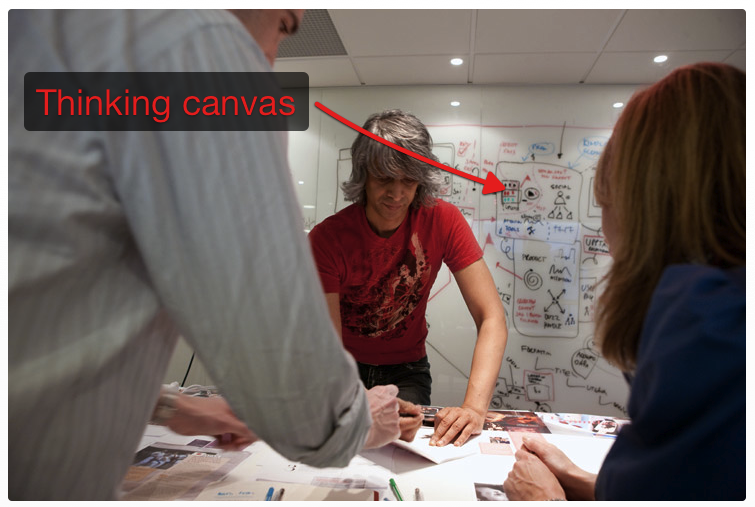
Part of the big picture includes the questions: “what will this lead to and where will it leave us?” See TLN end result and action for a broader view.
Getting from point A to point B requires steps. These steps have to be something specific that could be written on a to do list or plan. It it the process of going from vague to specific. It creates an action blueprint. It is bigger than project planning. It is bigger than operations. It is bigger than today. Sometimes it involves a sequence of work modules (example). Frequently it should contain a provision for appropriately refocusing attention on the overall blueprint and its individual components so the action designer maintains the designed focus and energy and avoids flow of events reactions—a fail-safe attempt. Something about mouse thinking needs to be added here.
Calendarizing doesn’t mean that every individual step or action has an assigned date. A master plan with a fool proof reminder system may be adequate in many cases. When the reminder comes due, we can review the plan to determine the next actions and schedule them.
Sometimes just a reminder to consider whether a issue or topic belongs on our radar is adequate.
See Peter Drucker’s annual review in My Life as a Knowledge Worker
At its highest level, calendarization is the systematic process of getting to the “right” topics, the “right” concepts and then from these “right” concepts to the “right” daily action.
Assumptions and limited mental landscapes can be a barrier to getting to “right” concepts.
A foundation for future directed decisions is essential for getting to the “right” topics and concepts. More on foundations further down the page.
Conceptual resources can help discover and explore both topics and concepts.
Conceptual resource list
Concepts to Daily Action provides the raw materials for harvesting conceptual resources. The outputs of this process are ingredients for an individual’s calendarization processing.
Calendarizing is facilitated by thinking broad and thinking detail.
Edward de Bono’s thinking brainscape may help: Six Thinking Hats and Six Action Shoes

Larger
A way to use conceptual resources: (from a Peter Drucker book)
See Opportunities by Edward de Bono
Images from Flying Logic website
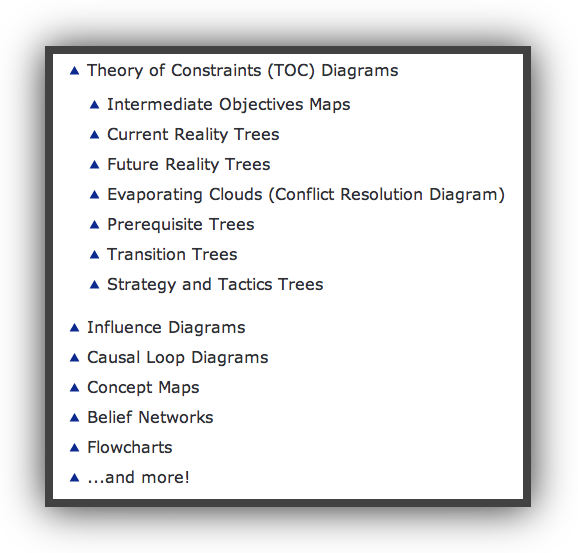
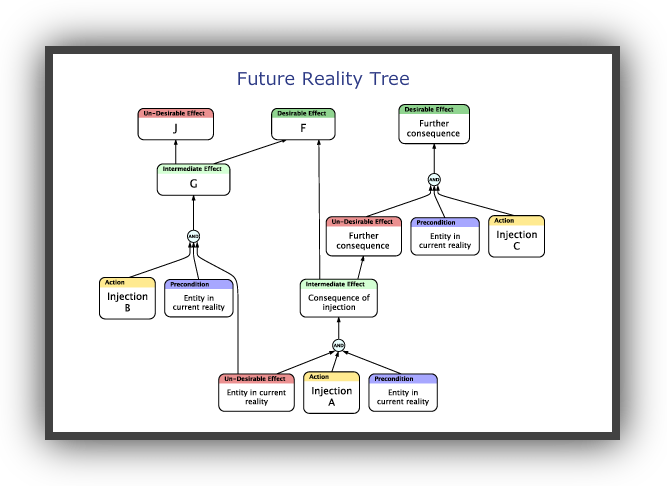
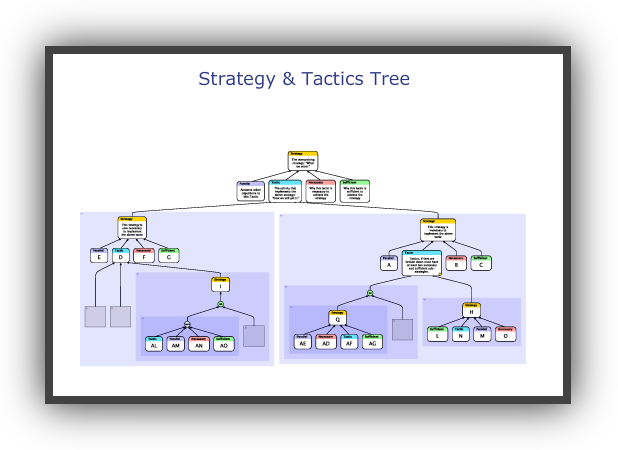
back to top?
David Allen’s project planning. Software: structured note-taking, mind and concept mapping, outlining, simple project planning. Plain copy paper and colored pens are also useful in getting started.
A hierarchical master action list computer application—similar to OmniFocus, TaskPaper or TodoPaper maybe helpful in choreographing actions in various life areas. See my information-tools-mac tag on delicious.
Write An Action Plan
Executives are doers; they execute.
Knowledge is useless to executives until it has been translated into deeds.
But before springing into action, the executive needs to plan his course.
He needs to think about desired results, probable restraints, future revisions, check-in points, and implications for how he’ll spend his time.
First, the executive defines desired results by asking: “What contributions should the enterprise expect from me over the next 18 months to two years?
What results will I commit to?
With what deadlines?”
Then he considers the restraints on action: “Is this course of action ethical?
Is it acceptable within the organization?
Is it legal?
Is it compatible with the mission, values, and policies of the organization?”
Affirmative answers don’t guarantee that the action will be effective.
But violating these restraints is certain to make it both wrong and ineffectual.
The action plan is a statement of intentions rather than a commitment.
It must not become a straitjacket.
It should be revised often, because every success creates new opportunities.
So does every failure.
The same is true for changes in the business environment, in the market, and especially in people within the enterprise—all these changes demand that the plan be revised.
A written plan should anticipate the need for flexibility.
In addition, the action plan needs to create a system for checking the results against the expectations.
Effective executives usually build two such checks into their action plans.
The first check comes halfway through the plan’s time period; for example, at nine months.
The second occurs at the end, before the next action plan is drawn up.
Finally, the action plan has to become the basis for the executive’s time management.
Time is an executive’s scarcest and most precious resource.
And organizations—whether government agencies, businesses, or nonprofits—are inherently time wasters.
The action plan will prove useless unless it’s allowed to determine how the executive spends his or her time.
Napoleon allegedly said that no successful battle ever followed its plan.
Yet Napoleon also planned every one of his battles, far more meticulously than any earlier general had done.
Without an action plan, the executive becomes a prisoner of events.
And without check-ins to reexamine the plan as events unfold, the executive has no way of knowing which events really matter and which are only noise.
The Effective Executive
Effective decisions involve calendarization.
Also see topic work and action plans
WHAT to calendarize is of paramount importance.
Maybe the first thing revolves around the question: “what do you need to do keep from having a serious financial problem?”
The second area of calendarization should be Managing Oneself and managing oneself for effectiveness as an action foundation for everything else
Creating a non-competitive life
You could calendarize the development of your life management system (LNS) or life navigation system (LNS)
For practice, you could calendarize your life-long vacation plans. What would have to be done and when for these vacations to be mouth wateringly attractive in prospect and wonderfully memorable?
You could create and maintain a list of areas to calendarize.
More calendarization clues: broad topic area examples
If you ran across either of the following passages what would you calendarize?
The First Technological Revolution and Its Lessons
For the first time in thousands of years, we face again a situation that can be compared with what our remote ancestors faced at the time of the irrigation civilization.
It is not only the speed of technological change that creates a revolution, it is its scope as well.
Above all, today, as seven thousand years ago, technological developments from a great many areas are growing together to create a new human environment.
This has not been true of any period between the first technological revolution and the technological revolution that got under way two hundred years ago and has still clearly not run its course.
Chapter 7, “The First Technological Revolution and Its Lessons,”
Technology, Management and Society
by Peter Drucker
Anticipating and Planning Technology
The “unpredictability of technology” is an old slogan.
Indeed, it underlies to a considerable extent the widespread “fear of technology.”
But it is not even true that invention is incapable of being anticipated and planned.
Indeed, what made the “great inventors” of the nineteenth century—Edison, Siemens, or the Wright brothers—"great” was precisely that they knew how to anticipate technology, to define what was needed and would be likely to have real impact, and to plan technological activity for the specific breakthrough that would have the greatest technological impact—and, as a result, the greatest economic impact.
It is even more true in respect to “innovation” that we can anticipate and plan; indeed, with respect to “innovation,” we have to anticipate and plan to have any effect.
And it is, of course, with “innovation” rather than with “invention” that the businessman is concerned.
Innovation is not a technical, but a social and economic, term.
It is a change in the wealth-producing capacity of resources through new ways of doing things.
It is not identical with “invention,” although it will often follow from it.
It is the impact on economic capacity, the capacity to produce and to utilize resources, with which “innovation” is concerned.
And this is the area in which business is engaged.
It should be said that technology is no more “predictable” than anything else.
In fact, predictions of technology are, at best, useless and are likely to be totally misleading.
Jules Verne, the French science fiction writer of a hundred years ago, is remembered today because his predictions have turned out to be amazingly prophetic.
What is forgotten is that Jules Verne was only one of several hundred science fiction writers of the late nineteenth century—which indeed was far more the age of science fiction writing than even the present decade.
And the other 299 science fiction writers of the time, whose popularity often rivaled and sometimes exceeded that of Jules Verne, were all completely wrong.
More important, however, no one could have done anything at the time with Jules Verne’s predictions.
For most of them, the scientific foundations needed to create the predicted technology did not exist at the time and would not come into being for many years ahead.
Chapter 3, “Business and Technology,”
Toward the Next Economics and Other Essays
by Peter Drucker
What are the opportunities time and history have (will) put within your grasp? — Peter Drucker
Calendarizing combined with the right strategic work plan (the product of upstream calendarizing) reduces the mental burden of juggling balls.
You might want to harvest the ideas (from this page) that you want to implement and then create a work map.
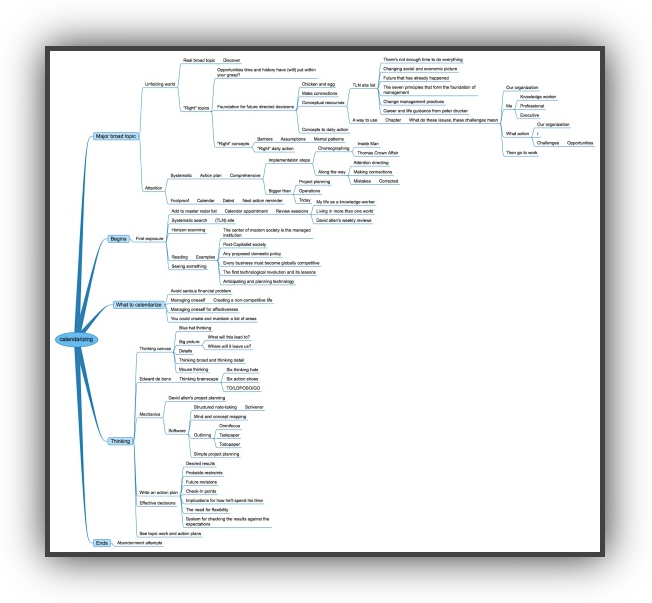
Larger
TLN Keywords: tlnkwcalendarize calendarization tlnkwcalendarization calendarizing tlnkwcalendarizing calendarize calendarized tlnkwcalendarized
|
![]()
